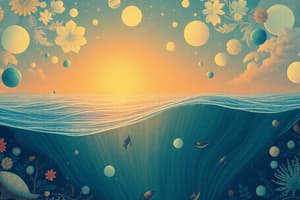Podcast
Questions and Answers
What is the primary effect of marine pollution on the ocean's surface?
What is the primary effect of marine pollution on the ocean's surface?
- It blankets the surface, interfering with the oxygen exchange between the sea and the atmosphere (correct)
- It blocks the sunlight, affecting marine life
- It increases the water temperature, affecting marine life
- It increases the oxygen exchange between the sea and atmosphere
What is a possible consequence of pollutants entering seawater distilling inlets?
What is a possible consequence of pollutants entering seawater distilling inlets?
- Contamination of drinking water (correct)
- Disruption of marine life habitats
- Damage to shipping vessels
- Increased risk of accidents on oil rigs
Which of the following is NOT a main source of marine pollution?
Which of the following is NOT a main source of marine pollution?
- Domestic wastes
- Run-off from agricultural pesticides and herbicides
- Radioactive waste disposal (correct)
- Oil exploration and exploitation activities
What is a possible cause of pollution from shipping and maritime activities?
What is a possible cause of pollution from shipping and maritime activities?
What is the purpose of the International Convention Relating to the Intervention of the High Seas in case of Oil pollution (Intervention), 1969?
What is the purpose of the International Convention Relating to the Intervention of the High Seas in case of Oil pollution (Intervention), 1969?
What is a consequence of pollutants entering the food chain?
What is a consequence of pollutants entering the food chain?
Which of the following is an example of operational pollution from ships?
Which of the following is an example of operational pollution from ships?
What is the primary concern related to pollution from agricultural activities?
What is the primary concern related to pollution from agricultural activities?
What was the primary concern for IMO in the 1960s?
What was the primary concern for IMO in the 1960s?
What was the approximate amount of crude oil spilled into the sea by the Torrey Canyon in 1967?
What was the approximate amount of crude oil spilled into the sea by the Torrey Canyon in 1967?
What was the outcome of the 1969 IMO Assembly decision?
What was the outcome of the 1969 IMO Assembly decision?
What was the primary focus of the 1973 Convention?
What was the primary focus of the 1973 Convention?
What was added to OILPOL 1954 in 1971?
What was added to OILPOL 1954 in 1971?
What was the purpose of Annex I of the 1973 Convention?
What was the purpose of Annex I of the 1973 Convention?
What was the significance of the Torrey Canyon incident in 1967?
What was the significance of the Torrey Canyon incident in 1967?
What was the main outcome of the Extraordinary session of the IMO Council in 1967?
What was the main outcome of the Extraordinary session of the IMO Council in 1967?
What is the primary purpose of the plan outlined in the MARPOL Convention?
What is the primary purpose of the plan outlined in the MARPOL Convention?
In what language must the plan be written?
In what language must the plan be written?
What is the minimum requirement for the plan?
What is the minimum requirement for the plan?
What is the title of the combined plan for ships that also apply to regulation 17 of Annex II of the Convention?
What is the title of the combined plan for ships that also apply to regulation 17 of Annex II of the Convention?
What is the purpose of the list of authorities or persons to be contacted in the event of an oil pollution incident?
What is the purpose of the list of authorities or persons to be contacted in the event of an oil pollution incident?
Why is a detailed description of the action to be taken immediately by persons on board necessary?
Why is a detailed description of the action to be taken immediately by persons on board necessary?
What is the purpose of the procedures and point of contact on the ship for coordinating shipboard action with national and local authorities?
What is the purpose of the procedures and point of contact on the ship for coordinating shipboard action with national and local authorities?
Who developed the guidelines for the plan?
Who developed the guidelines for the plan?
What is the minimum distance from the nearest land that an oil tanker must be to discharge oil or oily mixtures into the sea?
What is the minimum distance from the nearest land that an oil tanker must be to discharge oil or oily mixtures into the sea?
What is the maximum instantaneous rate of discharge of oil content allowed for an oil tanker?
What is the maximum instantaneous rate of discharge of oil content allowed for an oil tanker?
What is the total quantity of oil that can be discharged into the sea for a tanker delivered on or before 31 December 1979?
What is the total quantity of oil that can be discharged into the sea for a tanker delivered on or before 31 December 1979?
What type of ballast is exempt from the discharge provisions of Regulation 34?
What type of ballast is exempt from the discharge provisions of Regulation 34?
What is the gross tonnage threshold for oil tankers to carry a shipboard oil pollution emergency plan?
What is the gross tonnage threshold for oil tankers to carry a shipboard oil pollution emergency plan?
What is the gross tonnage threshold for ships other than oil tankers to carry a shipboard oil pollution emergency plan?
What is the gross tonnage threshold for ships other than oil tankers to carry a shipboard oil pollution emergency plan?
What system is required to be in operation on an oil tanker to discharge oil or oily mixtures into the sea?
What system is required to be in operation on an oil tanker to discharge oil or oily mixtures into the sea?
In which areas is the discharge of oil or oily mixture from the cargo area, slop tanks, DCBT/CBT, cargo pump-room bilge of an oil tanker prohibited?
In which areas is the discharge of oil or oily mixture from the cargo area, slop tanks, DCBT/CBT, cargo pump-room bilge of an oil tanker prohibited?
What is the maximum permitted residue in the tank and its associated piping left after discharge for products in categories X, Y, and Z for ships constructed on or after 1 January 2007?
What is the maximum permitted residue in the tank and its associated piping left after discharge for products in categories X, Y, and Z for ships constructed on or after 1 January 2007?
What is the purpose of the GESAMP2 Hazard Profile?
What is the purpose of the GESAMP2 Hazard Profile?
Why are vegetable oils now required to be carried in chemical tankers?
Why are vegetable oils now required to be carried in chemical tankers?
What is a provision under regulation 4 Exemptions for ships certified to carry individually identified vegetable oils?
What is a provision under regulation 4 Exemptions for ships certified to carry individually identified vegetable oils?
What is the purpose of the MEPC resolution on Guidelines for the transport of vegetable oils?
What is the purpose of the MEPC resolution on Guidelines for the transport of vegetable oils?
What is the effective date of the guidelines for the transport of vegetable oils?
What is the effective date of the guidelines for the transport of vegetable oils?
What was adopted at the session, reflecting the changes to MARPOL Annex II?
What was adopted at the session, reflecting the changes to MARPOL Annex II?
What is the primary purpose of the revision of Annex II?
What is the primary purpose of the revision of Annex II?
Flashcards are hidden until you start studying
Study Notes
MARPOL 73/78
- Ozone Depleting Substances (ODS) Record Book is required
Pollution
- Definition: Inconvenience or damage caused by human activities to humans, animals, plants, and the environment by spreading compounds into air, water, and land
- Effects:
- Blankets the surface, interfering with oxygen exchange between sea and atmosphere
- Blankets the seabed, interfering with marine life growth
- Pollutants are toxic and can enter the food chain
- Interferes with recreational uses of beaches
- Pollutants may enter seawater distilling inlets and be deposited on tidal mudflats
- Main sources:
- Oil exploration and exploitation activities
- Domestic wastes
- Run-off from agricultural pesticides and herbicides
- Shipping and maritime activities
- Causes of pollution from ships:
- Accidents (e.g. grounding, collision, fire/explosion, hull failure, capsizing)
- Operations (e.g. loading, discharging, lightering, ballasting, de-ballasting, tank washing, bunkering)
International Conventions
- International Convention Relating to the Intervention of the High Seas in case of Oil Pollution (Intervention), 1969
- Convention on the Prevention of Marine Pollution by dumping of Wastes and other Matter (LDC), 1972
Torrey Canyon Incident (1967)
- The tanker Torrey Canyon ran aground, spilling 120,000 tons of crude oil into the sea
- Raised questions about measures to prevent oil pollution from ships and exposed deficiencies in the existing system for providing compensation following accidents at sea
IMO Response
- Called an Extraordinary session of its Council to develop a plan of action on technical and legal aspects of the Torrey Canyon incident
- Convened an international conference in 1973 to prepare an international agreement for placing restraints on the contamination of the sea, land, and air by ships
MARPOL 73/78 Convention
- Adopted in 1973 to address oil pollution from ships
- Incorporated OILPOL 1954 and its amendments into Annex I, covering oil
- Also covers other forms of pollution from ships, including chemicals, harmful substances carried in packaged form, sewage, and garbage
Regulation 34: Control of Oil Discharge from Oil Tankers
- Prohibits discharge of oil or oily mixtures from slop tanks, cargo tanks, DCBT/CBT, cargo pump-room bilge of oil tankers, except under certain conditions
- Conditions include:
- Outside special areas
- More than 50 nautical miles from the nearest land
- Proceeding en route
- Instantaneous rate of discharge of oil content does not exceed 30 liters per nautical mile
- Total quantity of oil discharged into the sea does not exceed a specified amount
- Tanker has an oil discharge monitoring and control system and slop tank arrangement in operation
Regulation 37: Shipboard Oil Pollution Emergency Plan
- Every oil tanker of 150 tons gross tonnage and above and every ship other than oil tanker of 400 tons gross tonnage and above shall carry on board a shipboard oil pollution emergency plan
- Plan must be approved by the Administration and include:
- Procedure to report an oil pollution incident
- List of authorities or persons to be contacted in the event of an oil pollution incident
- Action to be taken immediately by persons on board to reduce or control the discharge of oil
- Procedures and point of contact on the ship for coordinating shipboard action with national and local authorities in combating the pollution
Amendments to MARPOL Annex II
- Effective 1 January 2007, maximum permitted residue in tanks and associated piping left after discharge will be set at 75 liters for products in categories X, Y, and Z
- Result of the hazard evaluation process and new categorization system, vegetable oils will now be required to be carried in chemical tankers
- Provision for the Administration to exempt ships certified to carry individually identified vegetable oils, subject to certain provisions relating to the location of the cargo tanks carrying the identified vegetable oil
Studying That Suits You
Use AI to generate personalized quizzes and flashcards to suit your learning preferences.




